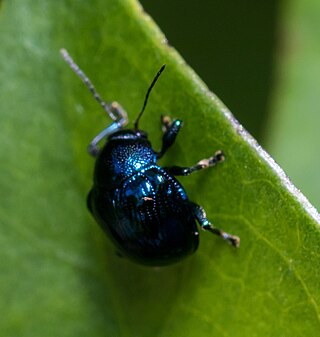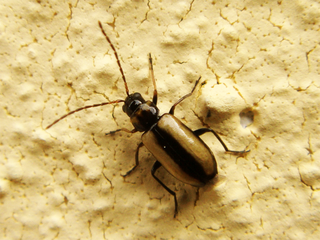
Chrysolina is a large genus of leaf beetles in the subfamily Chrysomelinae. Most species are distributed in Europe, Asia and Africa with a small number of species inhabiting North America and introduced species in Australia.
Longitarsus suturellus is a species of beetle in the subfamily Galerucinae. It is distributed in the Palearctic realm from the Pyrenees to Japan. Adult beetles and larvae feed on the leaves of sage (Senecio) (Asteraceae).

Longitarsus quadriguttatus is a species of beetle in the leaf beetle family. It is distributed in Central and south-eastern Europe, Asia Minor and the Caucasus. Adults and larvae feed on the leaves of Boraginaceae species, as well as Cynoglossum officinale and Echium vulgare.

Chrysolina herbacea, also known as the mint leaf beetle, or green mint beetle, is a species of beetle in the family Chrysomelidae.
Longitarsus obliteratus is a species of beetle from Chrysomelidae family.

Neocrepidodera is a genus of flea beetles in the family Chrysomelidae, containing some 100 described species worldwide.

Colasposoma is a genus of leaf beetles in the subfamily Eumolpinae. It is known from Africa, Asia and Australia.

Oreina is a genus of broad-shouldered leaf beetles belonging to the family Chrysomelidae, subfamily Chrysomelinae.
Longitarsus weisei is a species of beetle from Chrysomelidae family.
Neocrepidodera cyanescens is a species of black coloured flea beetle from Chrysomelidae family that can be found in Austria, Czech Republic, France, Italy, Poland, Romania, Slovakia, Slovenia, Switzerland, and Ukraine.
Pachnephorus tessellatus is a species of leaf beetle in the subfamily Eumolpinae. It is widely distributed across Europe and Asia, and is also present on the Canary Islands. It was first described by Caspar Erasmus Duftschmid in 1825.

Macrocoma is a genus of leaf beetles in the subfamily Eumolpinae. It contains about 100 species, which are found in tropical Africa, around the Mediterranean, on the Canary Islands, in western and central Asia, and in India.

Pachnephorus is a genus of leaf beetles in the subfamily Eumolpinae. It is distributed in Africa, Asia and Europe.

Eumolpini is a tribe of leaf beetles in the subfamily Eumolpinae. It is the largest tribe in the subfamily, with approximately 170 genera found worldwide. Members of the tribe almost always have a longitudinal median groove on the pygidium, which possibly helps to keep the elytra locked at rest. They also generally have a subglabrous body, as well as appendiculate pretarsal claws.

Cleorina is a genus of leaf beetles in the subfamily Eumolpinae. It is known from Australia and Asia.

Calomicrus is a genus of beetles belonging to the family Chrysomelidae.










